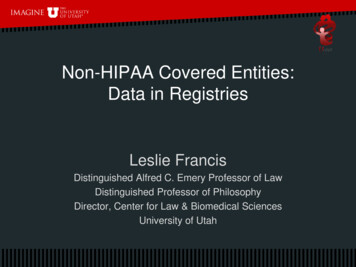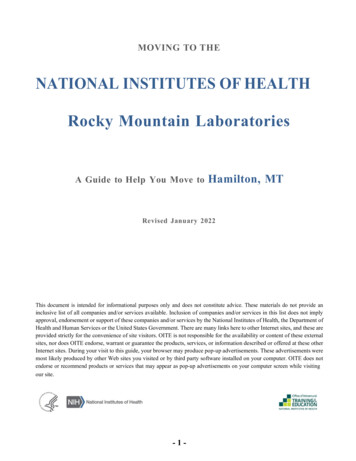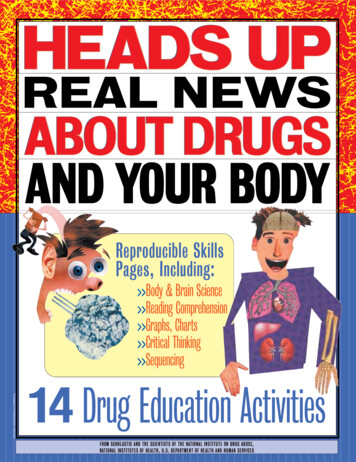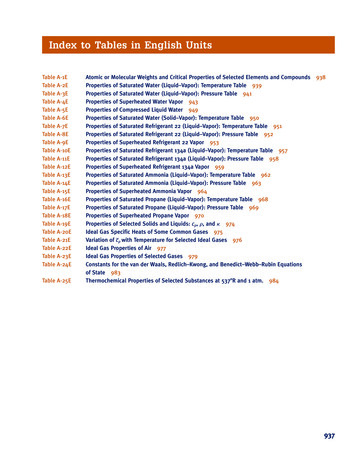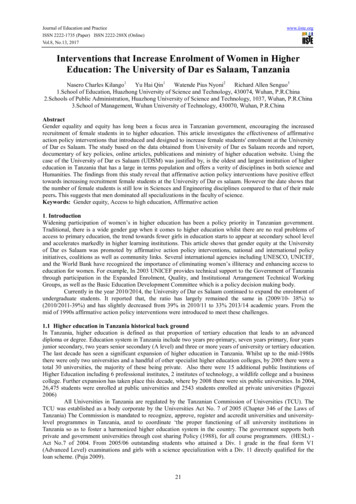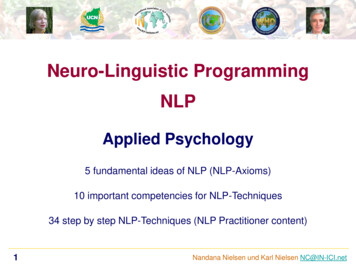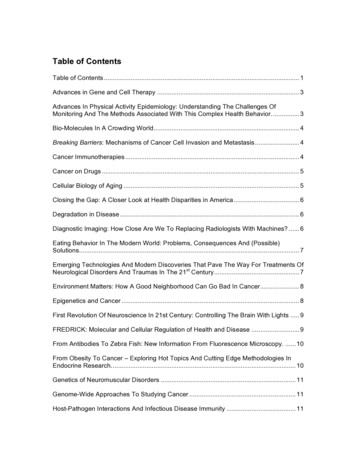
Transcription
Table of ContentsTable of Contents . 1Advances in Gene and Cell Therapy . 3Advances In Physical Activity Epidemiology: Understanding The Challenges OfMonitoring And The Methods Associated With This Complex Health Behavior. . 3Bio-Molecules In A Crowding World. 4Breaking Barriers: Mechanisms of Cancer Cell Invasion and Metastasis . 4Cancer Immunotherapies . 4Cancer on Drugs . 5Cellular Biology of Aging . 5Closing the Gap: A Closer Look at Health Disparities in America . 6Degradation in Disease . 6Diagnostic Imaging: How Close Are We To Replacing Radiologists With Machines? . 6Eating Behavior In The Modern World: Problems, Consequences And (Possible)Solutions. 7Emerging Technologies And Modern Discoveries That Pave The Way For Treatments OfNeurological Disorders And Traumas In The 21st Century . 7Environment Matters: How A Good Neighborhood Can Go Bad In Cancer . 8Epigenetics and Cancer . 8First Revolution Of Neuroscience In 21st Century: Controlling The Brain With Lights . 9FREDRICK: Molecular and Cellular Regulation of Health and Disease . 9From Antibodies To Zebra Fish: New Information From Fluorescence Microscopy. . 10From Obesity To Cancer – Exploring Hot Topics And Cutting Edge Methodologies InEndocrine Research. . 10Genetics of Neuromuscular Disorders . 11Genome-Wide Approaches To Studying Cancer . 11Host-Pathogen Interactions And Infectious Disease Immunity . 11
How Cells Control Their Fate: Multidisciplinary Approaches To Investigate CellularDevelopment. . 12How Do We See Color? – Making Sense of It With Thyroid Hormone. . 12Human Viruses: Scientific Advances Behind Science Daily Headlines . 13Lipid Membrane-Protein Interactions - A Structural Insight Into Membrane Fission AndFusion. 13Live Action Angry Birds: Pandemic Influenza Strains Past, Present and Future . 14Making Movies: How Immune Cells Get Together and How They Conduct TheirBusiness . 14MicroRNAs and Human Diseases . 15Mouse Models Of Pathology: A Picture Speaks Volumes . 15Non-protein-coding RNAs and Neurodegeneration . 15Reprogramming To Pluripotency . 16Reversing The Arrow Of Development And Induced Pluripotent Stem Cell Generation. 16Science in the News: Actual Data vs Media’s Perspective . 17SHADY GROVE: Cancer Epidemiology: Etiology, Prevention, and Policy . 17The Dark Art Of Cellular Alchemy: Leprosy, Viruses, And Stem Cell Reprogramming . 17The Future Of Personalized Medicine: Using Genomics In Cancer Profiling . 18The Neurobiology of PTSD: Preclinical and Clinical Evidence . 19Them and Us: The Role of the Gut Microbiome in Human Health and Disease . 19Transcription: Master Regulator Of Gene Expression . 19Vaccines: Why You Have No Clue What Diphtheria Is . 20
Advances in Gene and Cell TherapyDescription: Gene and Cell Therapy are relatively new and exciting fields of researchthat aim to treat inherited and acquired diseases. Gene therapy requires the use ofgenetic material to treat a disorder, while cell therapy uses whole cells. Bloodtransfusions and bone marrow transplants are two well-known methods of cell therapy.In this journal club we will discuss the classic examples of gene and cell therapy andstudy some of the advances in the field, like T-cell treatment of leukemia and Factor XIIIreplacement in hemophilia. Members will learn about methods and protocols for geneand cell therapy as well as how to critically evaluate scientific publications.Co-leaders: Jeanelle Spencer PhD, NCI; and Tania Felizardo PhD, NCIDates/Time/Location: Wednesdays (June 26th, July 3rd, 17th, 24th, and 31st); 12 -1pm;Building 10 CRC 4E-3330Directions: From the north entrance of Bldg. 10- Walk to the central elevators behindthe information desk. Take the elevators to the 4th floor. Walk through the corridor tothe East Research Labs. The conference room will be on the right.Advances In Physical Activity Epidemiology: UnderstandingThe Challenges Of Monitoring And The Methods AssociatedWith This Complex Health Behavior.Description: Physical activity, bodily movement produced by the contraction of skeletalmuscle that substantially increases energy expenditure, is a complex health behavior. Itis an outcome of the interactions among: personal attributes (demographics, biomedical,psychological), characteristics of the behavior (skill requirements for the activity), andenvironmental factors (physical environment, social environment, culture, timeconstraints). Fundamental human movements may exert specific metabolic,cardiorespiratory, hormonal, psychological, or musculo-skeletal effects which are notwell characterized. This journal club will explore some of the challenges, changes, andlimitations of how researcher’s measure physical activity as an exposure and healthoutcomes associated with physical activity. Members will learn that while physicalactivity is often limited to: a behavior that can be self-reported, or a movement that canbe measured by an objective device and classified into light, moderate or vigorous;some measurement tools that are more optimal than others. We will also discuss how tomake an informed decision when choosing a monitoring tools and methods in physicalactivity research.Co-leaders: Jeremy Steeves, PhD, MPH, NCI; and Britni Belcher, PhD, MPH, NCIDates/Time/Location: Thursdays (July 11th, 18th, 25th, and August 1st); 1-2 pm; Building10 CRC, Conference Room on the Metabolic Unit 5 SWN
Bio-Molecules In A Crowding WorldDescription: Biochemical reactions in living cells take place in media in which allspecies of bio-molecules taken together occupy a significant fraction of the fluid volume,instead of a simple diluted buffer system in which most of the current experimentscarried out. Behaviors of large macromolecules or macromolecular assemblies in a cellwould be expected to be greatly affected by the presence of high concentrations of cosolutes. The ubiquity of this phenomenon in biological fluids has been compared to thatof gravity. This journal club will cover publications on the definition of crowding effect, theexperiment results affected by crowding effect, and variety of biochemical phenomenoncaused by crowding effect. Members will understand the importance of crowding effectand learn about methods and protocols accounting for the crowding problems as well ashow to critically evaluate scientific publications.Co-leaders: Di Wu, PhD, NIDDK; Xiao-Nan Zhao, PhD, NIDDKDates/Time/Location: Thursdays (June 27th, July 11th, 18th, 25th); 2-3 pm; Building 8,Room 122Breaking Barriers: Mechanisms of Cancer Cell Invasion andMetastasisDescription: The progression of cancer from a benign growth to malignant disease is amultistep process involving several signaling pathways. This journal club will reviewpublications that investigate key processes activated during the metastatic processincluding changes in adhesion, gain of motility, gain of invasion potential, activation ofsurvival mechanisms, and angiogenesis. Members will learn about the laboratorymethods used to study these important processes and how to read, evaluate andpresent scientific articles.Co-leaders: Carrie House, PhD, NCI; Ngoc-Han Ha, PhD, NCIDates/Time/Location: Monday (June 24th, July 8th, 15th, 22nd, and 29th); 12-1 pm.Building 10, Room 5-2550. Note: There will NOT be a meeting July 1.Cancer ImmunotherapiesDescription: The immune system has evolved to help protect us from infectiousdiseases such as bacteria and viruses. Interestingly, our immune systems also play arole in protecting us from developing cancer. Scientists have recently begun to harnessthe power of the immune system to successfully develop new cancer treatments. In thisjournal club, we will discuss the science behind “Cancer Immunotherapy” and learn howwe can manipulate the immune system to fight cancer. Topics such as basicimmunology, the role of the immune system during cancer development, and how wecan genetically engineer immune cells to target cancer, will be covered.Co-leaders: Amber Giles, Meera Murgai, and Adrienne LongDates: Tuesday, (July 2nd, 9th, 16th, 23rd, and 30th); 2-3pm; Building 10, Room 2W-3961.
Directions: From the clinical/North entrance, walk to the West wing. Walk to the end ofthe wing (pass through three doors) and take the elevator up to the 2nd floor. Stairs arealso located around the side of the elevator. We will post signs to help guide Interns tothe room for the first meeting.Cancer on DrugsDescription: We are at war with cancer. How can we, as scientists, come out on topand win this war? By discovering agents that will stop the cancer dead in its tracks andultimately lead to its mass destruction. In this journal club students will discuss andinvestigate the cancer drug discovery process from molecular targeting to preclinicaldevelopment to clinical trial. Each session will focus on one paper detailing an importantstage of the discovery process. Students will be expected to read the week's publicationahead of time and actively participate in group discussions. At the end we will help thestudents identify where their career goals fit into the process of drug discovery.Co-leaders: Thomas Prince, PhD, NCI; Young Lee PhD, NCI; and Bethanie MorrisonPhD, NCIDates/Time/Location: Fridays (July 12th, 19th, 26th, August 2nd); 11 am - 12 (noon);Hatfield Center (Building 10), Conference Room 3-2550Directions: Conference room 3-2550 is in the north central part of the Hatfield Center,which is the north half of Building 10. From the 1st floor of the North lobby of the HatfieldCenter, take either set of north elevators to the 3rd floor. The room is in between the twonorth elevators and directly across from 3 Clinical Director’s suites.Cellular Biology of AgingDescription: All living things undergo the process of aging. As an organism ages, manychanges occur at the cellular and molecular level that lead to a deterioration in theorganism’s health and fitness. In humans, a broad range of diseases are associatedwith aging including cancer, Alzheimer’s disease, arthritis, diabetes and heart disease.In addition to the various diseases caused by the normal aging process, there areinherited syndromes that cause premature aging, where aging is accelerated and lifeexpectancy is severely reduced. While the genetic causes of premature agingsyndromes have been identified, much is still unknown about the biology of bothpremature aging and aging in normal individuals. A wide range of model organisms areused to study the process of aging and the diseases of old age. In this journal club wewill discuss research papers that utilize a variety of experimental approaches to try tounderstand the cell biology of aging.Co-leaders: Rebecca Meseroll PhD, NIDDK; and Alison Walters PhD, NIDDKDates/Time/Location: Tuesdays (June 25th, July 9th, 16th, and 23rd); 2-3 pm ; Building 8,Room 302Directions: Take the elevator to the 3rd floor and turn left. Room 302 is the last roomon the left side of the corridor.
Closing the Gap: A Closer Look at Health Disparities inAmericaDescription: Health disparities (HD) are differences between specific population groupsregarding the incidence, prevalence, mortality and burden of disease and other adverse healthconditions. Despite ongoing efforts to reduce health disparities in the US, racial and ethnicminority populations still experience a higher incidence of chronic diseases, higher mortality andmorbidity, and poorer health outcomes when compared to non-minorities. More than one third ofadults in the US are obese, increasing their risk of suffering heart disease, hypertension anddiabetes. This interactive journal club will provide you with an introduction and background intoHD and obesity and obesity-related diseases in minority groups (i.e. African American).Participants will engage in interactive discussions of journal articles based on this particular HDtopic.Co-Leaders: Natasha Lugo-Escobar, PhD; Shauna Clark, PhD; and Yewon Cheon, PhDDates/Time/Location: Thursdays (July 11th, 18th, 25th and August 1st); 4-5 pm; LocationBuilding 2, Conference Room 2W15Degradation in DiseaseDescription: During the life-cycle of a cell, a considerable amount of cellular wastebuilds up and must be efficiently cleared and recycled. Many diseases, including cancer,neurodegenerative disorders, infection, and digestive disorders can be attributed todefects in cellular degradation pathways. This journal club will explore how the majorintracellular degradation pathways, the ubiquitin proteasome system, and theautophagy-lysosome pathway, can contribute to disease development and bemanipulated to treat disease.Co-leaders: Danielle Sliter, PhD; and Adam Fogel, PhDDates/Time/Location: Tuesdays (June 25th, July 2nd, 9th, 16th, 23rd, and 30th); 10-11am;Building 35 Room 3BC-900Diagnostic Imaging: How Close Are We To ReplacingRadiologists With Machines?Description: With invention of new medical imaging techniques and state-of-the-artreliable algorithms for organ segmentation, quantification and diagnosis; the need forhuman assistance is fast diminishing; but are we on our way to completely replaceradiologists? Specifically, this journal club will discuss the algorithms and applications ofthe current state-of-the-art CAD systems for multiple imaging modalities (CT, MR, PETas well as PET-CT and MRI-PET) with much of the focus on the automated analysis oforgans and pathologies, such as infectious disease inflammation as well as canceroustumors. And how close are we to fully computerized radiologists?Co-leaders: Awais Mansoor, PhD; Ziyue Xu, PhD; Brent Foster, BSDates/Time/Location: Tuesdays (July 9th, 16th, 23rd, 30th); 4 -5 pm; Building 10, 1C331
Eating Behavior In The Modern World: Problems,Consequences And (Possible) SolutionsDescription: The aim of this journal club is to gain a better understanding of why we eatwhat we eat, how our genetic makeup, predispositions and environment influence thefood choices we make, and how our eating behavior influences physical andpsychological health outcomes. If energy intake consistently exceeds energyexpenditure, overweight and obesity are inevitable consequences. People with excessbody weight may suffer from a number of eating-related diseases, social stigma and lowself-esteem. Furthermore, our food choices may also have potential consequences onothers, such as on our offspring. Some weight loss interventions could offer a promisingsolution. Members will learn about the determinants and consequences of problematiceating, will explore methods to promote adaptive eating behavior and will learn how tocritically evaluate scientific publications.Co-Leaders: Sofia Bouhlal, PhD; Dina Eliezer, PhD; and Eszter Szekely, PhD,NHGRI/SBRBDates/Time/Location: Wednesdays (June 26th, July 3rd, 10th, and 17th); 9:30 - 10:30 am;Building 31 Room B1E12/14Directions: The journal Club will be held on the B1 level of Bldg. 31. You’ll note, thereare A, B and C wings to the building. When you enter through the A wing, immediatelyturn to your right and take the elevators down one floor to the B1 level. When youemerge from the elevators, turn towards the “Self Service Store” and go down thehallway that the Self Service Store is in. You will find Room E12/14 on your right, beforethe double doors. The Journal Club is held in room E12/14. Knock on the door if it islocked and somebody inside the room will open it for you. It would be great if you arriveby 9:20am.Emerging Technologies And Modern Discoveries That PaveThe Way For Treatments Of Neurological Disorders AndTraumas In The 21st CenturyDescription: The brain’s complex nature can be seen, at its highest potential, throughour personalities and the changes that we go through throughout our lives. On thedownside, neurological disorders and nervous system traumas claim the lives andpersonalities of millions each year. Among some of the better known ones for whichmodern medicines and techniques are available, include Alzheimer’s and Parkinson’sDiseases; yet, neither of them can be cured and researchers are still hoping to find ordevelop methods to better understand and diagnose them and hundreds of others. Whileit is clear that we are still far away from fully understanding how our brains work, recentmajor technological advances in areas such as optogenetics, microfluidics, tissueengineering and deep brain recording and stimulation, in combination with thedevelopment of novel molecular probes are paving the way for scientists to finallyunravel the mysteries of the brain. This journal club will cover topics ranging from axonguidance, synaptic specificity and circuit establishment, to the modern day tools andtechniques that are being used to study these processes under healthy and diseasedstates. Members will learn about methods and protocols behind the uses and
implementation of many of these techniques in the field of neuroscience, as well as howto critically evaluate scientific literature.Co-leaders: Oleg Milberg, NIDCR; Lyudmila Kotlyanskaya, NINDSDates/Time/Location: Wednesdays; (July 3rd, 10th, 17th, 24th, 31st); 10:30 - 11:30 am;Building 30, Room 318 (3rd floor conference room).Environment Matters: How A Good Neighborhood Can GoBad In CancerDescription: While the frequently discussed elements of cancer are the cellular driversof the cancer cell, increasingly there is awareness of the contribution of the nonmalignant elements in the cancer mileu. It is the goal of this journal club to discuss activeareas of research working towards elucidating the different elements of the cancermicroenvironment that contribute to disease initiation and progression. The particulartopics to be covered in this journal club will include readings and discussions relating tothe contributions of: fibroblasts, inflammatory mediators/cells and extracellular matrix tothe cancer phenotypeCo-leaders: Adele Blackler PhD, LP, NCI; Avi Z Rosenberg MD, PhD, LP, NCIDates/Time/Location: Thursdays, (June 27th, Jul 11th, 18th, 25th, Aug 1st); 12:00 – 1:00pm; Building 10, B1C119 Conference RoomDirections: From the elevator lobby next to Masur auditorium go down to B1 level,continue down the N corridor towards 1N100. The corridor will turn into an elevatorbank. At the elevator bank go past the vending machines to the left and around thecorner. B1-C119 is at the end of the hallway, below Lipsett Theater.Epigenetics and CancerDescription: Epigenetics is an exciting and rapidly developing field that is defined asgene expression changes not due to alterations in the DNA sequence but rathermediated by a chromatin-based mechanism. Chromatin, the macromolecular complex ofDNA and histone proteins, is the basic architecture that packages our entire genome.While cancer is known as a disease of aberrant genomic changes, there is growingevidence that epigenetics is of vital importance to understanding the molecularmechanisms of cancer. In this journal club, we will explore the multiple roles thatepigenetics play in the development and progression of specific cancers. We will focuson recent publications that examine various types of epigenetic regulation (i.e. histonemodifications, chromatin remodeling and non-coding RNAs) and how that regulation isaltered in cancer. Lastly, we will delve into how discovery of certain epigenetic playershave become potential targets for treatment of certain cancers.Co-Leaders: Wenqi Ran, PhD, NLM/NCBI; Jiyeon Choi, PhD, NCI; Tara Burke, PhD,NICHD
Dates/Time/Location: Thursdays (June 27th, July 11th, 18th, 25th, and August 1st); 45:30pm; Building 38A Room 5N506.First Revolution Of Neuroscience In 21st Century:Controlling The Brain With LightsDescription: Optogenetics is a neuromodulation technique applyed in behavioralneuroscience that controls the activity of individual neurons from living tissue to freelymoving animals by introducing light-activated ion channels. It is the first strategy enablehuman to control brain activity and behaviors precisely with both high spatial andtemporal resolutions. In this journal club we will discuss how the scientists developedoptogenetic technique; how optogenetics have been helped us during exploration thebrain function and the prospect to use it in psychotic diseases treatment.Co-leaders: Shuxi Liu, PhD, NINDS; Jiansong Sheng PhD, NINDS; and Marc Lussier,PhD, NINDSDates/Time/Location: Fridays (June 28th, July 5th, 12th, 19th); 3:00-4:00 pm; Building 35(Porter Neuroscience Research Center) 2CD900Directions: The conference room 2CD900 is on the 2nd floor of building 35 facing south(the parking garage). Get into building 35 from the main entrance on Lincoln Drive. Takethe elevators on the right side of the hall way to floor 2R. Go straightforward to thekitchen of pod C, and the conference room 2CD900 is on the left side.FREDRICK: Molecular and Cellular Regulation of Health andDiseaseDescription: In this journal club, up to two papers will be presented by students eachweek, allowing 30 minutes per paper with some extra time for discussion. The paperswill be selected based on the research interest of the labs that the students are workingin. Students will pick papers and prepare presentations. Postdoctoral discussion leaderswill provide assistance and facilitate discussion. We have postdoctoral fellows withexpertise in a wide variety of fields, including cancer research, immunology, stem cellbiology, metabolism, and therapeutics, who have volunteered to help.Co-leaders: Balamurugan Kuppusamy PhD, NCI; and Sameer Issaq PhD, NCIDates/Time: Wednesdays (June 26th, July 3th, 10th, 17th, 24th, 31st, and August 7th); 23:30 pm;Location: Frederick, MD campus, Building 549: Conference Room A (on June 26th, July10th, July 24th, July 31st); Conference Room B (on July 3rd, and August 7th); andExecutive Boardroom (on July 17th)
From Antibodies To Zebra Fish: New Information FromFluorescence Microscopy.Description: Fluorescence is a popular technique in the biological sciences; it has beenwidely used everywhere from the labeling of antibodies for co-localization inside cells tomore ‘systems biology’ approaches of tagging molecules in tissue. This journal club willcover publications that explain novel applications in fluorescence microscopy including:different methodologies in super-resolution microscopy, two-photon excitationmicroscopy to go deep into tissue and single molecule techniques. Members will learnabout these methods; however, the approach taken by the authors and the potentialbiological significance of the results will be emphasized.Co-leaders: Tilman Rosales, PhD, NHLBI; Michael Brenner, PhD, NHLBIDates/Time/Location: Thursdays (June 27th, July 11rd, 18th, 25th); 11 am- 12 noon;Building 50, Room 3328From Obesity To Cancer – Exploring Hot Topics And CuttingEdge Methodologies In Endocrine Research.Description: The study of the endocrine system has undergone a dramatic evolution inthe last two decades, from traditional physiologic studies that dominated the field formany years to the inception of molecular endocrinology and endocrine genetics. Thisjournal club will cover interesting and exciting new research on a variety of keyendocrine related fields including obesity, endocrine tumors and rare endocrinediseases. Members will learn about the use of various genetically engineered mice, aswell as zebrafish, once used primarily by developmental biologists, now acquired bycancer biologists, and other approaches in translational research. Bring along yourmorning coffee/tea to discuss some of the exciting and somewhat quirky side ofendocrine research.Co-leaders: Eva Szarek PhD, NICHD; Edra London PhD, NICHDDates/Time: Tuesdays or Thursdays (Tue June 25th, Tue July 2nd, Thurs July 11th, TueJuly 16th, Thurs July 25th, and Tue July 30th); 10-11 am.Location: Building 10, Room 4-3330 Hatfield Clinical Center (on Tuesday meetings) andBuilding 10 Room 6 – B1C208 FAES (on Thursday Meetings)Directions:Hatfield Clinical Center - Room 4-3330:From the Main Lobby of the CRC, go down the left corridor past the Coffee Shop. (Donot take the Central Elevators.) Look for the "1 East Corridor" sign on your left and takethat door to the end of the hallway. Once there, take the "Southeast Elevators" up to thefourth floor. Conference room 4-3330 is located behind the glass, adjacent to the fourthfloor elevator lobby.FAES Classrooms - Room 6 - B1C208:
From the Masur Auditorium, go north, past the Central Elevators. Look for abookstore/coffee shop on your right and a sign from the ceiling saying "FAES AcademicCenter." Take a right down the hallway, through the double-door; then take the stepsdown to the lower level. Rooms 1-4 are on your right and Rooms 5-8 are on your left.Genetics of Neuromuscular DisordersDescription: In this journal club we will explore current diagnostic and therapeutic toolsfor use in neuromuscular disorders, including muscular dystrophies and disordersaffecting motor and sensory neurons. Collectively, these rare diseases are frequent, butstill the genetic cause of a large number of them remains unknown, and for all of them,few therapeutic strategies have been translated into clinical practice. Currently there isno cure for any of them. The papers chosen will cover applications in use in the field,such as exome sequencing, induced pluripotent stem cells, and gene-based therapies.Co-leaders: Veronique Bolduc, PhD, NINDS; Kristen Zukosky, NINDSDates/Time/Location: Thursdays (July 11th, 18th, 25th, and August 1st); 1-2 pm; Building35 Room 2AB-1000Genome-Wide Approaches To Studying CancerDescription: We will how the basic techniques of genome-wide association studies arecurrently being applied to studying cancer. Some techniques we will look at are singlenucleotide polymorphism (SNP), copy number variation (CNV), and chromatinimmunoprecipitation followed by deep-sequencing (ChIP-Seq). We will discuss howthese techniques and their applications are furthering the fields of cancergenetics/genomics.Co-leaders: Jacqueline Barlow, NCI; Robert Faryabi, NCIDates/Time/Location: Wednesdays (July 10th, 17th, 24th, 31st); 12-1 pm; Building 37Room 1109Directions: Bldg. 37 is located next to the South Drive entrance to the Bethesdacampus from Old Georgetown Road. Room 1109 is located in the northwest corner ofthe building on the first floor.Host-Pathogen Interactions And Infectious DiseaseImmunityDescription: During an infection, there is a battle between the pathogen and the host,the result of which determines the severity of disease and clinical outcome. On one side,pathogen virulence factors aid in the replication and spread of infection, while on theother, host protective innate and adaptive immune responses aim to limit disease.Pathogens may evade, inhibit, or manipulate host responses to establish a niche.Moreover, inappropriate or exaggerated responses can exacerbate disease. This journalclub will explore the interaction between medically important pathogens and the human
host. Together, we will examine a variety of literature on this topic, and members willgain experience in analyzing data from in vitro, animal, and clinical studies.Co-leaders: Andrew Broadbent, DVM PhD, NIAID; Ping Chen, MD PhD, NEIDates/Time/Location: Thursday (June 27th (1-2pm), July 11th, July 18th, July 25th, andAugust 1st); 12:30-1:30 (except for June 27th, 1-2 pm); Building 10, Room 10N202(Cogan). Note: The first meeting on June 27th will be from 1-2 pm. The rest of themeetings will take place 12:30-1:30 pm.Directions: Room 10N202 is located on the 10th floor of Building 10. Take the mainelevator, near the Masur Auditorium, to the 10 th floor, and you will find the North corridorand Room 10N202.How Cells Control Their Fate: Multidisciplinary ApproachesTo Investigate Cellular Development.Description: Modern biologists utilize a wi
Gene and Cell Therapy are relatively new and exciting fields of research that aim to treat inherited and acquired diseases. Gene therapy requires the use of genetic material to treat a disorder, while cell therapy uses whole cells. Blood transfusions and bone marrow transplants are


